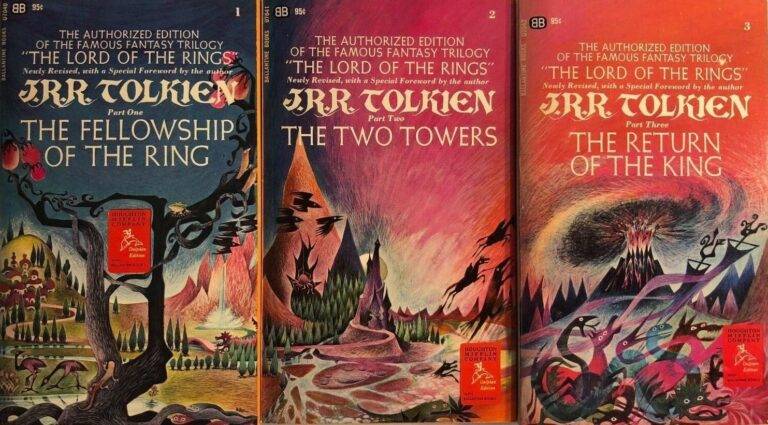The Lord of the Rings: The Fellowship of the Ring Turns 70
Seventy years ago, on July 29 1954, ‘The Lord of the Rings: The Fellowship of the Ring’ was published. The first part of J.R.R. Tolkien’s magnum opus, it would go on to become one of the most important books ever published, having a huge impact on popular culture. Terry Pratchett, creator of the Discworld series, once said that most post-Lord of the Rings fantasy simply “rearranges the furniture in Tolkien’s attic,” which is a big complement to just how impactful the book has been. Indeed, it’s gone on to be an inspiration for other equally important works, such as George Lucas’s ‘Star Wars’, and the ‘Harry Potter’ novels by J.K. Rowling. The medieval European style of Middle-earth has gone on to set the scene for most high fantasy books, giving popularity to creatures like goblins, elves, and dwarves.
Despite being the starting point for modern fantasy literature, ‘The Lord of the Rings’ did so much more than the works that have followed it when it came to world building, establishing the fictional Middle-earth and filling it with a deep history and reality that few other settings have. Tolkien took great care to ensure that everything had a purpose, a history and a beginning, rather than simply being put there because it would look good in the story. Whenever characters stumble on an ancient ruin, he explains its origin and former importance, and as a result, makes it one of the most convincing fictional worlds ever created.
This has a lot to do with Tolkien’s own methods for creating Middle-earth. He started inventing his own languages when he was young, which led to him building a completely imaginary world to support them. This naturally required a deep history to be made to give meaning to the languages of Dwarvish and Elvish. This would be a great task that took most of Tolkien’s life to even partially complete, and he published very little that wasn’t set in Middle-earth.
Among Tolkien’s most important creations were the Hobbits. The main heroes of his work, these small beings, who stood only three feet tall, were the heart of ‘The Fellowship of the Ring’. Hobbits are the definition of rural English folk, and are close to Tolkien’s heart in many ways. He loved the English countryside, having come to the country from South Africa when he was very young. A love for the rural landscape would stay with him for life, with a fondness for trees in particular. He would often be disheartened by the effects of industrialization and urbanization on the countryside.
Hobbits live like rural English people, and are quite literally small folk, isolated from the outside world, unaware of its dangers and happy to remain that way. They have a small government and enjoy the simple things in life, like good food and pleasant company, and don’t much like excitement or adventure. This makes their involvement in the destruction of the Ring all the more remarkable, as they are the most unlikely heroes. Yet, Frodo Baggins and Samwise Gamgee prove to be the most important players in the fight against Sauron.
Away from the page, Tolkien’s work has an equally interesting story. It began as a sequel to ‘The Hobbit’, his first work set in Middle-earth which was published in 1937. Over the course of its creation, ‘The Lord of the Rings’ became a much larger work than its predecessor, and took on a more serious tone. In the end it took Tolkien over a decade to complete, finally being ready in the early 1950s. Even then, there were obstacles to overcome. Tolkien’s publisher didn’t believe it would be a success and to try and alleviate some of the risks of printing such a large and costly book, it was split into three volumes, with the first part, ‘The Fellowship of the Ring’ being published in July 1954. Despite the doubts of its publisher, it became a huge success, prompting multiple reprints to keep up with demand, and leading to Tolkien becoming something of a celebrity in later life, receiving a large amount of mail from dedicated fans.
Reviews of the book were mixed. Tolkien’s friend and author of ‘The Chronicles of Narnia’, C.S. Lewis said “Nothing quite like it was ever done before,” while the poet W.H. Auden was admiring, saying that “No fiction I have read in the last five years has given me more joy than ‘The Fellowship of the Ring’.” On the negative side, reviewing the series in 1956, literary critic Edmund Wilson wrote, “Dr. Tolkien has little skill at narrative and no instinct for literary form.”
All of these reviews can be seen as valid, as the ‘Fellowship of the Ring’ was like nothing else published before, but it was also unconventional in many ways. The story takes a long time to start, beginning in the Shire with Bilbo preparing for his birthday party, and it’s not until over halfway through that the Fellowship is actually formed and the quest starts in earnest. There are also many things a modern editor would want to cut out, like the long exposition scenes by Gandalf and Aragorn, detailing their travels sometimes for pages with nothing else happening. Then there are constant references to the history of Middle-earth, and the complicated names and languages used, as well as long pieces of poetry and song. When read as a conventional novel, ‘Fellowship’ can seem strange and difficult to get through, but when you understand what Tolkien is doing, and that he’s much more focused on creating a realistic world than crafting an ordinary narrative structure, then the work takes on a completely new meaning. It becomes an epic filled with meaning, almost an alternate history, and a documentation of the struggle against a powerful enemy. It’s this uniqueness that separates it from everything else written in the fantasy genre and that’s given it such a long period of popularity.
Over the past seventy years, ‘The Lord of the Rings’ has established itself as the most important piece of fantasy literature ever written, and it still remains as popular as ever. Its fictional setting and timeless prose style means it doesn’t feel as rooted in the era it was written, unlike ‘Narnia’, which features 1940s schoolchildren and their vernacular, and as a result, dates the books.
Middle-earth is ageless, and so are the stories it tells, with nothing to place it in a particular time or place other than the one it creates. There’s a strength in Tolkien’s way of writing that gives it an ageless quality similar to the ancient myths and legends that still impact our culture, and that means there’s a potential for his works to last forever.




